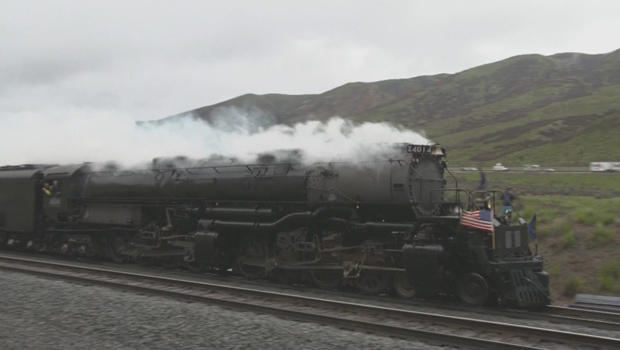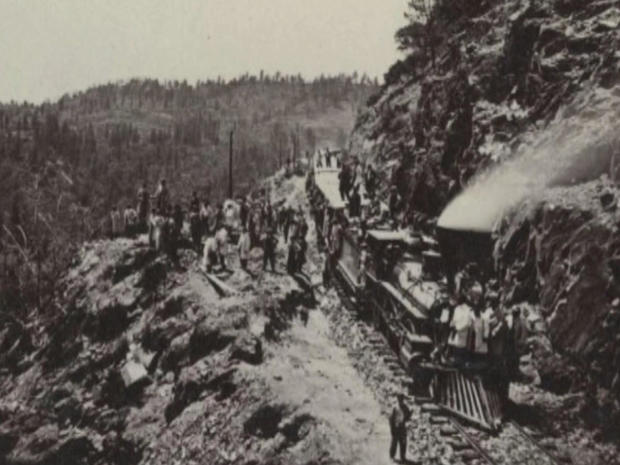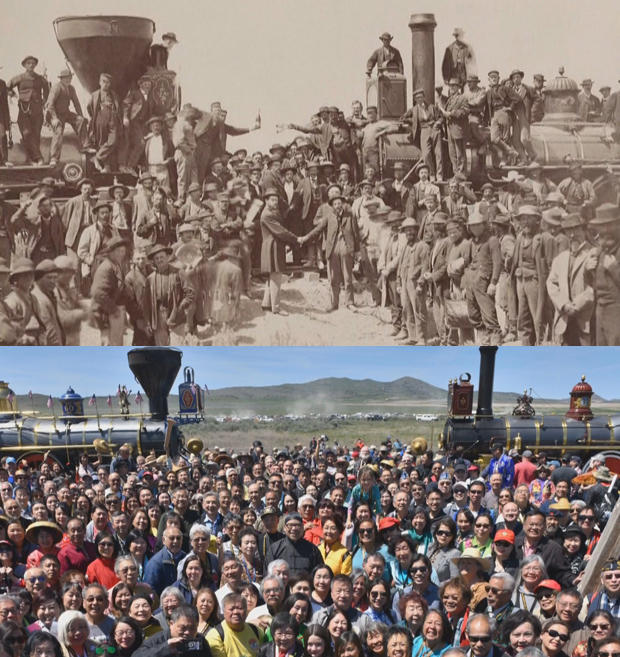Building the Transcontinental Railroad, the moonshot of the 19th century
Last edited Mon Jun 17, 2019, 03:14 PM - Edit history (1)
Hat tip, Trainorders: Steam & Excursion > CBS News Sunday Morning piece on the 150th / 4014
Building the Transcontinental Railroad, the moonshot of the 19th century
It's something railroad enthusiasts believed they might never see again: one of the biggest steam locomotives ever built in America back on the tracks, rumbling west under its own steam. As Union Pacific # 4014 pulled out of Cheyenne, Wyoming, crowds lined the tracks, waving at engineer Ed Dickens, urging one more pull of the whistle. ... "I don't know what it is about that whistle," he said. "We hear whistles, we hear horns in our life, but the steam locomotive is really something that just moves you."

The Union Pacific steam locomotive 4014. CBS NEWS
Dickens led the small team of Union Pacific workers who spent five years toiling to bring the massive machine back to life. ... 4014 is one of just 25 locomotives built in the 1940s, aptly named "Big Boys" – 132 feet long, weighing more than a million pounds, producing 7,000 horsepower. But when the Age of Steam came to an end in the late 1950s, 4014 became obsolete, until Dickens and his team brought it back to life. ... Their goal was to get 4014 rolling again in time to celebrate one of the greatest rail accomplishments ever: the Transcontinental Railroad, built at the urging of President Lincoln.
Dickens said, "It's very humbling. All of the sacrifice, all of the tremendous human effort to build something as complex as a set of railroad tracks across territory that many people have never even been across before."

One hundred and fifty years ago, crews working west from Omaha and east from Sacramento (including up to 20,000 Chinese laborers) constructed a 1,776-mile-long railroad across an untamed frontier. CBS NEWS
Crews worked from both the East and the West, finally meeting on May 10, 1869, at Promontory Summit, Utah. It was, one enthusiast called it, "the moonshot of the 19th century. It was an impossible dream."
At Golden Spike National Historical Park, rail fans dressed in style to mark the anniversary … if not always with historical accuracy. An Abe Lincoln impersonator, once he got off his cellphone, told Blackstone, "I wasn't the only one that had the idea, but I was thankful to have a big part of it." ... Replicas of Victorian steam locomotives rolled in for a re-enactment of the legendary photo celebrating the driving of the golden spike. ... But the faces in that photo from 150 years ago look much different from those gathered here this time.

Promontory Summit, Utah in 1869, and today. CBS NEWS
"It took 150 years to gain that recognition. So our history is now coming alive!" said Sue Lee. ... They are descendants of the Chinese laborers who made up about 90 percent of the workforce on the western portion of the railroad. ... "The workers on the line who cleared the way for the railroad, who laid the roadbed and laid the track, laid the ties and so forth, then especially did tunnels, [were] almost exclusively Chinese," said Gordon H. Chang, a history professor at Stanford University. He is author of a newly-released book, "Ghosts of Gold Mountain: The Epic Story of the Chinese Who Built the Transcontinental Railroad"
Not only was the Chinese labor force plentiful, the workers were paid less than whites doing the same job. And the work was hard. They took on the most challenging portion of the Transcontinental Railroad: California's granite mountain range, the Sierra Nevada.
....
Story produced by John Goodwin.
© 2019 CBS Interactive Inc. All Rights Reserved.
zipplewrath
(16,646 posts)They ran roughshod over alot of people to build that thing. But there's no doubt that one way or another it was going to be built. And the value to the country was enormous.
But it's probably a more apt comparison to the Interstate Highway system than the Moon Shot. No one knew how to build the rockets, or do the orbital mechanics to go to the moon when they started. They knew how to build trains and tracks.
cojoel
(957 posts)Grafting millions to a few executives, who also left Union Pacific in bankruptcy
https://en.wikipedia.org/wiki/Cr%C3%A9dit_Mobilier_scandal
HeartlandProgressive
(294 posts)Getting thru the Sierra Nevada and Rocky Mountains was a huge engineering challenge for the time. Some of the wooden trestle bridges they built have to be seen to be believed.
dixiegrrrrl
(60,010 posts)and included people making illegal profit from it.
The actor Common was a standout in it, btw.